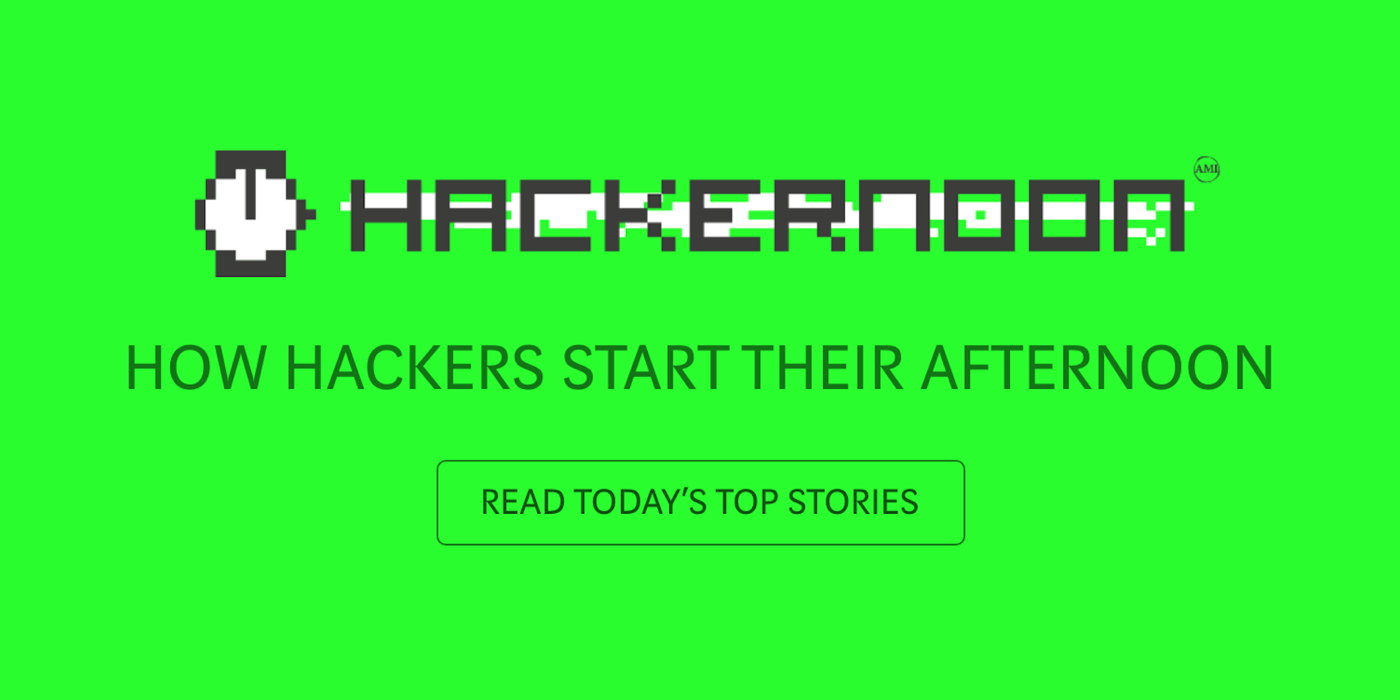Friday, December 28, 2018
Monday, December 24, 2018
Saturday, December 08, 2018
Sunday, November 25, 2018
Wednesday, November 21, 2018
Monday, November 12, 2018
Thursday, November 08, 2018
Saturday, November 03, 2018
Tuesday, October 30, 2018
Monday, October 29, 2018
Saturday, September 15, 2018
Thompson Cyber Security Labs: The Privacy Revolution in Action
Tuesday, September 04, 2018
Announcing the Casa Lightning Node – Casa Blog – Medium
Sunday, August 26, 2018
Peepeth — Social Network For A Better World by Bevan Barton — Kickstarter
Friday, August 17, 2018
Saturday, August 11, 2018
ASIC Resistance is Nothing but a Blockchain Buzzword
Wednesday, August 01, 2018
Re: OTC is Much Larger Than Bitcoin Exchange Volume: Where Real Whales Trade... klopt dit?
--
Monday, July 30, 2018
Blockstack Browser
Tuesday, July 24, 2018
#recksplorer
https://lnmainnet.gaben.win/
Wednesday, July 18, 2018
The Bulgarian Government Has More Bitcoins Than Satoshi Nakamoto - The Coin Owl
Tuesday, July 17, 2018
Wednesday, July 11, 2018
Opera test Ethereum-walletfunctie in mobiele Android-browser - Computer - Nieuws - Tweakers
Wednesday, June 27, 2018
Introducing GiveCrypto.org – GiveCrypto.org – Medium
Monday, June 25, 2018
Compound
Compound
A full-featured web interface to the Compound Protocol, used with MetaMask, Mist, or the Ethereum browser of your choice. Supply, borrow, or liquidate positions.
Friday, June 15, 2018
Geldspoor miljardenfraude met cryptomunten leidt naar ING - FTM
Thursday, June 14, 2018
Nieuwe Tribler-release integreert blockchain voor 'bandbreedte-tokens'
Tuesday, June 12, 2018
How I became Leonardo da Vinci on the Blockchain – Terence Eden's Blog
Monday, June 11, 2018
Tuesday, June 05, 2018
Top 10 Reasons To Not Use Exodus – Exodus Movement – Medium
Monday, June 04, 2018
Sunday, June 03, 2018
Tuesday, May 29, 2018
Sets are live on Radar Relay!
- EthereumX: The top 10 ERC20 tokens weighted by market-cap
- StableSet: An equal-weighted mix of live stable coins
- DEXSet: A mix of the major decentralized exchange protocol tokens
See more at tokensets.com
Monday, May 28, 2018
Tuesday, May 15, 2018
PGP email
https://itunes.apple.com/nl/app/canary-mail-secure-email-app/id1155470386?mt=8
Sunday, May 13, 2018
German online bank uses Bitcoins to transfer loans | Reuters
Tuesday, May 08, 2018
Why every Web Developer should look into Ethereum – Coinmonks – Medium
Friday, May 04, 2018
The Instability of Stablecoins – Hacker Noon
The Instability of Stablecoins
Three months ago we held a sigil for the death of the cryptocurrency bull market. Last month, my HodlBot portfolio went up by 50%. What a wild ride.
While this volatility doesn't bother long-term HODLers like myself, price instability is a large barrier to mass-adoption of cryptocurrency.
It's hard to use crypto to pay for stuff, when prices can fluctuate 20% day-to-day.
Stablecoins —the holy grail of cryptocurrency
Stablecoins claim to achieve price stability by pegging their own prices to stable assets like the USD.
The promise of stability has led many to call stablecoins the "holy grail of cryptocurrencies".
Despite the praise, history has taught us over and over that currency pegs can break, and cause wide-spread catastrophe when they do.
To name a few:
- 1994 Mexican peso crisis
- 1997 Asian financial crisis
- 1998 Russian financial crisis
- Argentine great depression
Pegging cryptocurrencies is dangerous. And it is a great irony that we do not recognize the stability stablecoins offer is just as elusive as Chrétien de Troyes's holy grail.
In this article, I will demonstrate the weaknesses and dangers of each of the 3 categories of stablecoins while providing poignant real life examples.
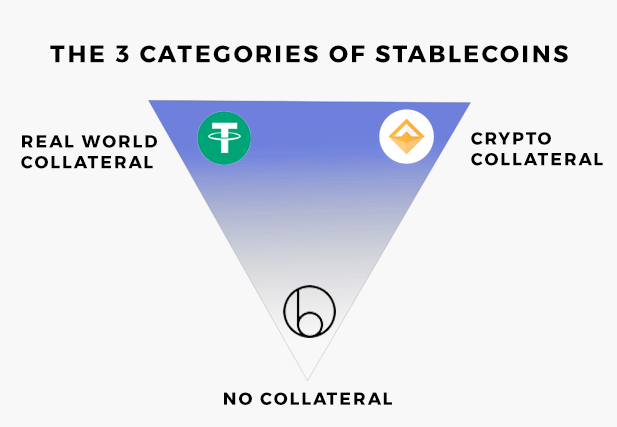
Stablecoins backed by Real World Collateral
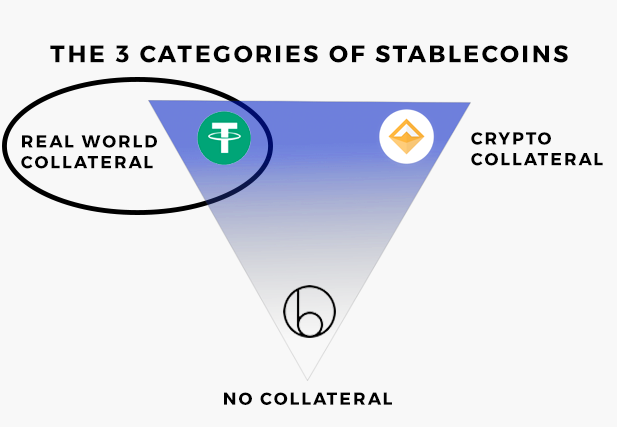
Stablecoins backed by real world collateral are simply a digital representation of fiat currencies or valuable commodities like gold.
USD Tether (USDT) is an example of stablecoin backed by real-world collateral. It is owned and operated by Bitfinex, one of the world's largest cryptocurrency exchanges. USDT claims to keep $1 USD on reserve for every unit of USD Tether issued. They also claim that Tethers are redeemable for USD on a 1:1 basis.
Major Weaknesses
While this seems like a great way to achieve price stability, there are some major weaknesses to this approach.
- We need to trust that the issuer will act honestly and not under-collateralize the digital assets issued.
- We need frequent professional audits to prove that the collateral is there because real world assets are not visible on the blockchain.
- Because collateral is not transparent, the stablecoin is weak to speculation and false rumours about how it is not sufficiently backed.
- There are many regulatory hoops to jump through when converting tokens for real-world assets. Barriers to convertibility makes the token less valuable.
The USDT Controversy
USDT is being accused by the cryptocurrency community of minting tethers not backed by USD, and critics have demanded independent audits to verify USDT's integrity.
So far, the situation does not look great. USDT's relations with their original auditor, Friedman LLP, deteriorated after Freidman asked for additional information that USDT was not willing to provide.
Recently, damning audio recordings have been released implicating USDT in fraud. Currently they are seeking another auditor to validate their records which Bitfinex'ed, a harsh critic of USDT, claims to be just a stalling tactic.
Impact of USDT Fraud on Cryptocurrency Market
Many think USDT fraud would only impact a small part of the total cryptocurrency market cap.
But JP Morgan estimates a 1:50 ratio between fiat-inflow and market cap. Given that USDT is effectively fiat-inflow, every USDT used to purchase cryptocurrency increases the overall market cap by $50.
If fake USDT are issued, then worthless USDT is being used to artificially prop a significant portion of the entire cryptocurrency market. Once the fraud becomes clear, the market goes boom.

Here's how /u/arsonbunny sees the collapse:
- Tether-enabled exchanges will see a massive spike in Bitcoin and cryptocurrency prices as everyone leaves Tether. Noobs in these exchanges will think they are now millionaires until they realize they are rich in tethers but poor in dollars.
- Exchanges that have not integrated Tether will experience large drops in Bitcoin and altcoins as experienced investors flee crypto into USD.
- There will be a flight of Bitcoin from Tether-integrated exchanges to non-Tether exchanges with fiat off-ramps. Exchanges running small fractional reserves will be exposed, further increasing calls for greater reserves requirements.
- The exchanges might slam the doors shut on withdrawals.
- Many exchanges that own large balances of Tether, especially Bitfinex, will likely become insolvent.
Scary right?
USDT is an example of what can happen when investors blindly place their trust in stablecoins to hold the correct amount of collateral. Let's not forget the purpose of cryptocurrency is to move away from this kind of centralization.
Stablecoins backed by Cryptocurrency Collateral

So now that we've seen how stablecoins backed by real world assets have trust issues, let's turn our attention to stablecoins that use cryptocurrency as collateral.
How they work
This category of stablecoins claims to achieve price stability by over-collateralizing cryptocurrency against the issued tokens.
For example, if we wanted to create a stablecoin that is backed by Ethereum, we'd issue 1 stablecoin worth $1 that is in turn collateralized by $2 of Ethereum (as opposed to 1 USD) . If ETH falls by 50%, our stablecoin would absorb the shock and still be valued at $1.
These stablecoins don't have the same trust issues because they can prove that the assets in reserve are locked up in smart contracts on the blockchain.
However, they are much more vulnerable to price shocks than their fiat-commodity counterparts. If the backed collateral were to crash hard enough, which is very possible in a volatile cryptocurrency market, price-stability would shatter.
Major Weaknesses
- Not capital efficient. Requires a ratio of collateral to stablecoin >1:1
- Only stable when cryptocurrency prices move in a neutral or positive direction
- Fragile to major price shocks that causes sell-offs and a broken peg
- While transparent in the assets that are being held, they are opaque how they actually work and are affected by the market. Their short-comings are disguised by technical white-papers. They are wolves in sheep's clothing.
BitUSD — A Cautionary Tale
BitUSD, a stablecoin created in 2013, exemplifies the weaknesses found in this model.

Warning: this model is pretty complex and its shortcomings are disguised by fancy jargon. We'll need to make an effort if we want to uncover the wolf in sheep's clothing.
Rather than making myself sick explaining how BitUSD works, I'm going to let Christopher Georgen take this one. He does a good job explaining it in plain English:
- Suppose that Alice wishes to create $1.00 worth of bitUSD (1 bitUSD).
- To do so, she must lock away $1.00 worth of Bitshares (the company's own issued cryptocurrency) plus some excess collateral amount to ensure that she has enough Bitshares locked away even if the price relative to USD drops.
- Once she has locked away this total amount, she receives 1 bitUSD from the BitShares network.
- Alice now sells this 1 bitUSD to Bob for $1.05 worth of Bitshares. Alice insists on charging Bob more than $1.00 because her collateral is at risk should the bitUSD/Bitshares price shift.
- Bob can redeem the 1 bitUSD he holds by submitting this request to the BitShares network. In such an event, an open market position with the least-collateral is forced to accept Bob's bitUSD in exchange for an amount of Bitshares determined by the current price.
Do you see the glaring problem?
If the price of Bitshares always rises, then everything is fine. The collateral gains in value relative to issued token so it can always cover what is owed.
But when prices start moving downwards fast enough, the excess, but now devalued collateral held by the least-collateralized position is not enough to cover what is owed.
What happens thereafter:
- The collateral evaporates faster than gasoline
- Maintaining the peg is impossible. It's going to break.
- A massive sell-off is triggered and the entire speculative bubble around BTSX goes poof.

MakerDAO Dai — Not so Stable Either
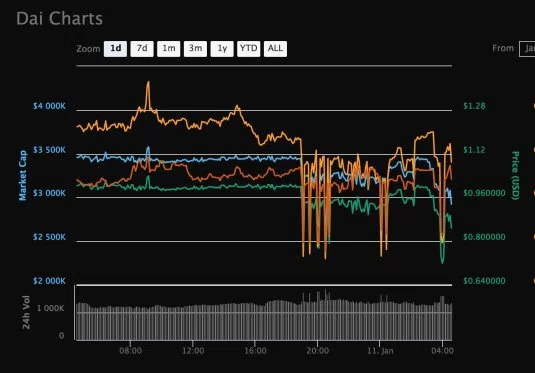
Christopher Georgen did such a good job explaining BitUSD I'll let him explain Dai too.
- Suppose that Alice wishes to create $1.00 worth of Dai (1 Dai).
- To do so, she must lock away $1.00 worth of ether, plus a specified amount of excess collateral, determined so that the position is collateralized above the liquidation ratio.
- Once she has locked away her collateral, she receives 1 Dai from the Dai system.
- Alice now sells this 1 Dai to Bob for $1.05 worth of ether. Alice insists on charging Bob more than $1.00 because her collateral is at risk and she must also pay a mandatory stability fee.
Like with BitUSD, everything is kosher when prices go up.
But when ETH prices go down, MakerDAO starts liquidating ETH collateral in anticipation so the value of Ether backing Dai doesn't go below 1:1.
In mild price downturns this is fine. But black swan crashes happen fast and they don't give you time to recover. In market meltdowns, selling ETH to liquidate Dai would actually contribute to driving the price down faster.
MakerDAO has a contingency plan for this. The community of MakerDAO MKR token holders will bailout DAI as a buyer of last resort.
Not to underestimate the MakerDAO community, but I really doubt any such community can stand against a torrent of sell-orders in a market crash.

Stablecoins Without Collateral
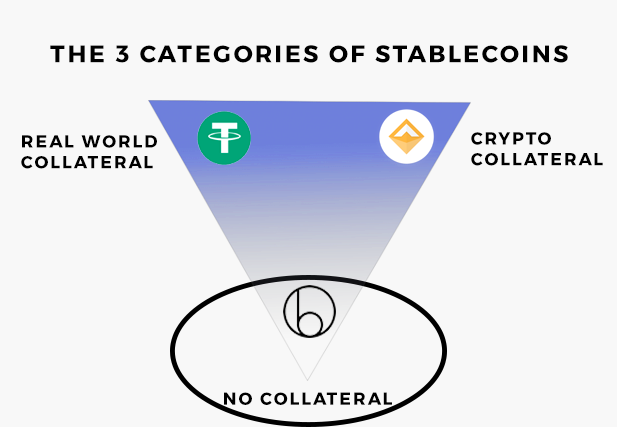
Now that we've already examined the 2 categories of stablecoins that require collateral, maybe you're thinking: "what if we don't need any collateral for a stablecoin?".
What if people just believe that the price should always go to $1, so they resolves discrepancies in the market through arbitrage? After all, fiat currencies are not backed by anything and they work.
Well my friend, we've made it to the final category of stablecoins and perhaps the most misunderstood: stablecoins without collateral.

How does it work
- We issue a currency that has only one mandate: it should trade at $1.
- We ensure the $1 trading price by controlling the monetary supply.
- If the price goes to $2, we increase the monetary supply by minting new tokens to reduce the price back to $1.
- If the price goes to $0.5, we reduce the monetary supply by buying back tokens to bring the price back to $1.
It is always possible to mint new tokens and increase the monetary supply. But, there is a limit to how many tokens we can buy back because we don't have infinite money.
For this reason when prices go below $1, non-collateralized stablecoins typically issue a bond that can be purchased for 1 coin. This bond is then redeemable in the future for $1 when the price of the coin goes back up.
Although it sounds like a fair solution, participants are only incentivized to purchase the bonds if they believe that the price of the coin will go up in the future. And in order to do that, there must be new entrants and net new inflow to subsidize the profit-taking of bond holders. Like we've seen before, stablecoins that only work when the market goes in a positive direction, tend to be not very stable at all.
Weaknesses
- Participants are only properly incentivized when the price goes up
- Requires inflows > outflows and a continuous stream of new buyers to maintain its peg
- Extremely vulnerable to crash — no collateral to back anything up
- Opaque system that is weaker to speculation because it is difficult to ascertain its true stability
- Shortcomings disguised by fancy whitepapers
Basecoin — A Proposed Solution to Stablecoins Without Collateral
Basecoin attempts to peg its price to 1 USD without the use of any collateral by controlling the money supply.
In order to do so, they issue two different kinds of tokens
- Base Bonds
- Base Shares
Base Shares are issued to early-adopters of Basecoin. When the price of Basecoin is above $1, new Basecoins are paid to Base Share holders as dividends. Newly minted Basecoins are then sold on the open market, increasing total monetary supply and bringing the price back down to $1.
When the price is below $1, Base Bonds are sold on the market for Basecoin. The bonds cost 1 Base Coin each and come with the promise to repay the bond holder $1 when the price of Basecoin goes back to the peg. The Basecoins used to buy these bonds are taken out of circulation and reduce the monetary supply, bringing the price back up to $1.
While this sounds fine and dandy, both Base Share and Base Bond holders are only properly incentivized when the demand and price of Basecoin goes up. After all who would want Base Shares if new coins are never minted? Who would want Base Bonds if they are never repaid with $1 Basecoins?
Token holders need to be able to take profits, or at least believe that they can. Otherwise they don't have a reason to want Base Shares and Base Bonds. For this to happen, they they need to be able to sell their assets to new entrants. The new entrants then need to find even more noobs, and on and on it goes.
No wonder that critics say Basecoin looks like a pyramid scheme.

Like DAI and Bitshares, everything works when the market goes up, but going downwards is a precarious fall.
When prices slip under $1 and there are too few bonds being purchased and not enough new entrants, the only way to keep the peg is to for insiders to simulate demand by making large artificial buys.
But at some point, it becomes too expensive to subsidize the difference what Basecoin think the price should be vs. what the market thinks the price should be. And as a result, the peg breaks.

Parting Thoughts — The Antifragility of Complex Systems
Although I appreciate the sentiment towards building a price-stable cryptocurrency, I'm just dubious about forcing volatile markets to be stable through man-made efforts.
Markets are complex systems that thrive on volatility. When we try to artificially repress natural movements, we are mistaking a complex system that does not respond linearly to inputs, for a simple one that does.

In the short-term we are able to achieve some artificial stability as long as market participants play along. But stablecoins claim to be stable, forever. And that is a promise that cannot be kept. If the history of markets have taught us anything it is that: the market will always decide what the price of something should be, rather than the other way around.
Maybe the answer to price-stability is one we don't want to hear. And that is price stability can only come with time when more real life uses emerge for cryptocurrency. Rather than stablecoins, perhaps that is the holy grail we should all be searching for instead.
About the Author
I'm the founder of hodlbot.io
We automatically diversify and rebalance your cryptocurrency portfolio into the top 20 coins by market cap. You can read more about our methodology here.
We ignore all stablecoins even if they are within the top 20 coins by market cap because we believe they are not a worthwhile long-term investment . The short-term stability they offer, comes with the risks as I have aforementioned.
Wednesday, May 02, 2018
The Future of Bitcoin: What Lightning Could Look Like - Bitcoin Magazine
The Future of Bitcoin: What Lightning Could Look Like
Aaron van Wirdum
After years of conceptualization and development, the first Lightning implementations are now in beta. As a result, more nodes are appearing online every day, a growing number of users are opening channels with one another, and some merchants even started to accept Lightning payments.
But of course, these are still the very early days of the Lightning Network. While the main implementations are usable and some wallets and other applications are available, Bitcoin's overlay payment network is projected to improve over the next few years in areas ranging from network architecture to security and usability, and more.
These are some of the more important Lightning projects currently in development.
Dual-Funded Channels
The Lightning Network consists of a series of payment channels. Each payment channel exists between two users, allowing funds to be sent back and forth between them.
However, in this early stage of development, payment channels can only be funded by one of the two parties. The funding party must first make a transaction to his counterparty; only then can that counterparty return a payment within the same payment channel.
The Lightning Network white paper, however, proposed dual-funded channels, for which a specification proposal has now also been made by ACINQ, the company behind eclair. As the name suggests, dual-funded channels will let both users partly fund a payment channel by each depositing some bitcoin. This should bring more flexibility to the Lightning user experience, as users can immediately send as well as receive payment after having opened a channel.
Submarine Swaps
In order to make a Lightning payment, users must deposit funds in a Lightning channel. Once in a channel, these funds cannot be sent to regular (on-chain) Bitcoin addresses (unless the channel is first closed). This means that bitcoin in a Lightning channel is somewhat separated from bitcoin in a regular wallet, not unlike how money in a checking account is somewhat separated from money in a savings account.
But there are solutions to make switching between Lightning and on-chain payments more seamless.
One solution is Submarine Swaps. Developed by Alex Bosworth (but conceptualized by Lightning Labs CTO Olaoluwa Osuntokun even before that), Submarine Swaps essentially let users send Lightning payments to a middleman on the Lightning Network; that middleman will send a corresponding amount of bitcoin to a regular (on-chain) Bitcoin address. It also works the other way around: users can send regular on-chain payments to the middleman; that middleman will then send a corresponding amount of bitcoin to a receiving Lightning node on the Lightning Network.
Importantly, with Submarine Swaps, this conversion is done "atomically." Using a trick that is already embedded in the Lightning Network, the Lightning payment and the on-chain payment can effectively be linked to each other. This makes it impossible for the middleman to steal funds by not forwarding the payment. (In agreement with the users, he could charge a small fee for his service.)
Splicing
Another solution to make the Lightning user experience more seamless is called "splicing." In essence, splicing would let a user "top up" funds in an existing Lightning channel, or "drain" funds from it, potentially while keeping the channel open.
The idea is simple. Any Lightning channel starts with an opening transaction, which ensures that both users consent to moving the funds in the channel. The rest of the Lightning channel consists of a series of subsequent transactions exchanged between the users, which aren't usually broadcast to the Bitcoin network. The funds in the opening transaction don't move until the channel is closed.
When "splicing in," users take the opening transaction to instead send funds to a replacement opening transaction, which includes more bitcoin, from one or both users. Once this new opening transaction confirms on the blockchain, the channel is topped up. Until the new opening transaction is confirmed, the two users can simply update both the old and the new channel at the same time to avoid any "channel downtime."
Conversely, when they "splice out," users take the opening transaction to send funds to a regular (on-chain) address, and potentially keep some of it in the channel using the same trick. This way, users can make on-chain transactions straight out of a Lightning channel.
Eltoo
Each time a new payment is made, Lightning channels between users are updated to reflect their mutual balances. The trick used to accomplish this currently includes a penalty for users who try to cheat by broadcasting an older balance (presumably because that older balance would pay them more). Cheating users can lose all the funds they have in a channel.
The problem is that the broadcasting of old balances is not always a cheating attempt. There are a number of scenarios in which users can accidentally broadcast an older balance; for example, because of a software bug or a backup gone wrong. In such scenarios, a complete loss of channel funds is quite a heavy punishment.
First published on April 30, 2018, eltoo is the newest proposal featured in this article. Developed by Blockstream's c-lightning development team — Dr. Christian Decker and Rusty Russell — and Lightning Labs' Osuntokun, eltoo updates a channel by building a chain of time-locked transactions, where each transaction spends funds from the previous one to reflect the latest channel balance.
If one user broadcasts an older transaction (representing an older channel balance), her counterparty has some time to broadcast the latest transaction (representing the latest channel balance).
A solution like this could work today, but it isn't practical in cases of failure. It would require that the entire chain of transactions be broadcast and recorded on the Bitcoin blockchain, more or less defeating the purpose of the Lightning Network. Decker therefore proposed a soft-fork change to the Bitcoin protocol to introduce a type of hierarchy in these types of transactions: any newer transaction can override any older transaction without requiring that all transactions in the entire chain be broadcast.
If this soft fork is adopted and activated on the Bitcoin network, Lightning users could create channels in both the current style and by using eltoo, depending on what they prefer.
Compact Client-Side Block Filtering
While the Lightning Network is a second-layer protocol, the Bitcoin blockchain itself is still relevant for Lightning users for security purposes. Specifically, Lightning users must keep an eye on the blockchain to see if specific transactions are included. This can be resource intensive, in particular for mobile users.
A solution for this is called Simplified Payment Verification (SPV) and was described in the Bitcoin white paper. Current SPV wallets use a trick called "Bloom filters" to find out whether any relevant transactions happened.
Unfortunately, Bloom filters are rather privacy-unfriendly, as wallets essentially reveal all of their addresses to nodes on the Bitcoin network. They also have some scaling and usability issues, as each individual SPV wallet takes up resources from at least one full Bitcoin node.
To tackle these issues, Lightning Labs' Osuntokun and Alex Akselrod, along with Coinbase developer Jim Posen, designed a new solution called "compact client-side block filtering," which they are implementing in the Neutrino wallet.
Compact client-side block filtering essentially inverts the trick that current SPV wallets use. Instead of wallets requesting transactions relevant to them by creating and sending out a Bloom filter to full nodes, full nodes create a filter for all Neutrino wallets. The Neutrino wallet then uses this filter to establish that the relevant transaction did not happen — which is really all that users need to know to be sure they are not being cheated. (If the filter produces a match, Neutrino fetches the relevant block to see if the match really concerns the exact transaction instead of a false positive.)
Interestingly, while this trick was designed with the Lightning experience in mind, it could be utilized to benefit regular light wallets as well.
Watchtowers
To avoid being cheated, Lightning users must keep track of potential on-chain transactions that could be relevant to them.
While compact client-side block filtering should make things much easier, users do need to "check in" once in a while to make sure they're not being cheated. If they forget to check, it creates a security risk.
"Watchtowers" are a potential solution that can be traced back to the Lightning Network white paper and has since been improved by Lightning Network white paper co-author and lit developer Tadge Dryja and others. As the name suggests, Watchtowers could let users outsource blockchain monitoring to third parties.
Current Watchtower designs are not set in stone but would roughly work like this. Whenever users update a channel, they send a small data package to a Watchtower. The first part of this package is a "hint" of a transaction they should look out for, as if it were a piece of a puzzle. This hint alone doesn't reveal anything about the content of the transaction that the Watchtower must look out for; users don't give up any privacy in this sense.
However, if the relevant transaction shows up in the Bitcoin blockchain, the Watchtower can use the hint to recognize it. Then, with the transaction data on the blockchain itself, the Watchtower can use the second part of the package they've received to reconstruct the penalty transaction. This penalty transaction sends all funds in the channel to the user that is being cheated. (Or in the case of eltoo, it just broadcasts the correct channel balance.) The penalty transaction can also be designed to let the Watchtower claim part of the funds as a reward, as an incentive to do its job.
Users can outsource channel monitoring to multiple Watchtowers. Even if one fails, another might not, limiting the risk for Lightning users to the point where it's arguably negligible.
Atomic Multi-Path Payments
What makes the Lightning Network a network is that the payment channels between users are interconnected. Users can pay across payment channels, through peers on the network that act as "middlemen," to users they don't have a direct channel open with.
However, right now a single payment must be routed over a single route. If one user wants to pay 5 mBTC to another, not only must he have 5 mBTC in a single channel, all the middlemen on the route must also have 5 mBTC ready in a channel to forward. The bigger a payment is, the smaller the odds of this being the case.
Atomic Multi-Path Payments (AMPs) could go a long way of solving this limitation. First proposed by Lightning Labs' Osuntokun and Conner Fromknecht, the idea is simple: Larger payments can be "cut up" into smaller pieces, all of which have their own route from the payer to the payee, through different middlemen.
A challenge to realize this solution is that Lightning payments can fail, which would in this case mean that a payment is made partially. Partial payments can easily be a bigger problem than no payment at all, however: a merchant won't be satisfied with a partial payment, while a customer won't be happy spending any money for nothing.
The solution to this problem is that AMPs use an extension to the hash time-locked contracts, which are already used along Lightning routes and involve passing secret data along a network. Using a trick similar to the one used by deterministic wallets (which generate multiple Bitcoin addresses from a single seed), the smaller pieces of a larger payment can only be redeemed by the payee if all of them are: if some secret data doesn't make it through the route whole, the entire payment fails.
Atomic Swaps
The Lightning Network is designed as a scaling layer for Bitcoin. But since many altcoins are software forks of Bitcoin's codebase(s), it's often not difficult to create similar scaling layers for these altcoins. Already, a small Litecoin Lightning Network exists, and more Lightning Networks are likely to follow.
Interestingly, these networks don't need to remain separated in the future.
Using a fundamental building block of the Lightning Network called "atomic swaps" (first proposed by Tier Nolan and realized on Lightning by Lightning Labs' Fromknecht), payment channels can be linked across different blockchains. In other words, a user can send bitcoin, and as long as a node on the network is willing to make the exchange, another user can receive the payment as litecoin.
Of course, this also means that users can send such payments to themselves: they can send bitcoin and receive litecoin. In effect, the Lightning Network could establish a network of trustless cryptocurrency exchanges.
For more information on this topic, see: "Atomic Swaps: How the Lightning Network Extends to Altcoins."
Channel Factories
The main benefit of the Lightning Network is arguably its potential to vastly increase the upper limit of bitcoin transactions without burdening the Bitcoin network. As long as two users both have funds in their channel, they can pay each other a virtually unlimited number of times, while only requiring two on-chain transactions: one to open a payment channel and one to close it.
Still, two transactions per payment channel could add up if Bitcoin and the Lightning Network gain more adoption over time.
A proposal by ETH Zurich researchers Christian Decker (also of Blockstream), Roger Wattenhofer and Conrad Burchert called "Channel Factories" could further decrease the average number of on-chain transactions required per payment channel, perhaps significantly.
Loosely based on an earlier Lightning-like proposal by Decker and Wattenhofer from 2015, Channel Factories are a type of payment channel that can exist among many users. Meanwhile, like any payment channel, a Channel Factory only ever requires two on-chain transactions. (If Schnorr signatures are implemented on Bitcoin, these transactions could be quite compact, even if it involves many users.)
The Channel Factories can, in turn, act sort of like "sub-channels" for the Lightning Network. Participants within a Channel Factory can open and close a virtually unlimited number of Lightning channels with each other, without requiring any additional on-chain transactions. By doing so, they could, in theory, bring the number of required on-chain transactions for the Lightning Network down by a magnitude.
For more information on this topic, see: "This New Scaling Layer Could Make Payment Channels Ten Times More Effective".
Thanks to Blockstream developer Christian Decker, Lightning Labs developer Conner Fromknecht, ACINQ CEO Pierre-Marie Padiou and others for information and feedback.


